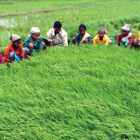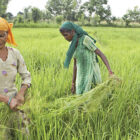Higher retail prices for food do not translate into profits for farmers because of higher production costs and marketing bottlenecks and the misgovernance of trade.
As governments across the world struggle to avoid urban civilian unrest triggered by rising food prices since 2008, farmers are increasingly being considered mere suppliers of cheap food. India is no exception, importing onions for fear of urban electorates voting incumbent governments out of power over rising food inflation. There will be no such worrying for the farmer if onion prices were to fall to ₹8 per kg in January 2014. As a farmer organisation, one is not as worried about rising food prices as one is about the farmer.
India’s farm sector is like a jigsaw puzzle in which the pieces do not seem to fit. From 1951 to 2011, milk production increased eight times, fish production 11 times and horticulture production 6.5 times. India has become the world’s largest producer of milk, the second-largest producer of fish and horticulture produce and the fifth-largest producer of meat. Yet, food inflation is in double digits. Fruit is cheaper than vegetables: kinnows cost ₹20 a kg against ₹40 for potatoes, and apples are ₹60 versus onions at ₹70.
The fact is that many of the pieces of the jigsaw are not located on the farm. For one, farmers are consumers too and, though they produce food, they also suffer from malnutrition because rising prices affect them. For another, higher retail prices for food do not translate into profits for them on account of higher production costs and marketing bottlenecks. For instance, nominal wages on the farm have increased 18 per cent every year for the last so many years, as a result of which farming has become a losing proposition.
Meanwhile, the government of India has monopolised the wheat and paddy trade through minimum support price purchases and the provisions of the food security bill. The procurement, storage and distribution of grain costs the government between ₹20 and ₹24 a kg. When the government sells grain for ₹2 to ₹3 a kg, there will have be no worries on account of food inflation on these items. Less than 10 per cent of any commodity produced in India is traded on the commodities exchange and there is no comparable inflation in any of those food items; in fact, there is some deflation.
At the other end is the surge in demand for different kinds of food, driven by the wage hike that accompanied the economic stimulus of 2008. This, plus India’s dependence on imported fuel, fertilisers and edible oil, the costs of which were aggravated by the sharply falling value of the rupee, saw food prices increase annually from 3.7 per cent to over 10 per cent ever since. Today, about a third of the Indian population, which is below the poverty line, can only aspire to buy more milk, eggs, fruit, vegetables and non-vegetarian food. As the masses are lifted out of poverty, diets and consumption habits will change in favour of these items. So prices will keep rising in real terms and not fall.
Price spikes are another matter altogether and can be managed. Consider the recent case of onions. The per capita availability of onion has increased from 4 kg to 12 kg in the last 10 years. It is, however, estimated that a five per cent shortfall in onion supply causes a 50 per cent increase in its price. Thus, even such a small fall in production can be easily manipulated by hoarders as a window of opportunity to corner a small portion of the market and jack up prices many times over. Indeed, the recent rise in onion prices is only partly because of lower production and principally due to the withdrawal of onion from the market by the traders between April and June 2013 and its controlled release thereafter.
The fact is that such price escalations do not last long but occur every season for different commodities year after year. For instance, the price of salt has risen on rumours alone. The real problem is that the government has not bothered to develop the capacity to pre-empt such panic buying by consumers and is unable to react in real time, allowing manipulators time to make a killing. Every day, the price differential between unregulated markets is substantially higher than the cost of transport between them owing to sheer manipulation. Wrong policies, lack of governance and enforcement at different levels are the problem and not the absence of laws.
The impetus must be to create systems for transparent data collection and economic research, which have been the bane of policy planning. Dependable weather forecasting and advisories are required to help farmers and the government plan and prepare for oscillations in the production cycle. Agriculture research and development are necessary to produce new field varieties that have a longer shelf life and offer higher yields.
Then again, less than three per cent of India’s horticulture produce is processed in comparison to over 40 per cent in some Asian counterparts. Overall, some ₹40,000 crore worth of food is wasted every year for lack of processing facilities. Yet the rate of growth of the food processing sector has consistently slowed over the last three decades. Until India is able to process excess production, price volatility will be unavoidable. Indeed, the prices of many horticulture commodities fluctuate over 100 per cent annually without any hue and cry.
There are other anomalies. Although production has increased many times over the last three decades the number of agriculture market yards has not increased. Agriculture infrastructure has lagged. For small farmers who normally grow vegetables, market intelligence is just not available and economies of scale are a constraint. Transporting the produce to the market is unviable. In Indonesia, farmers collectively aggregate, sort and sell directly to retailers. Cooperatives can provide the valuable link to ensure better farm gate prices and reduce the middleman’s margins to control retail prices. Private sector involvement is needed to correct the fragmented value chain. Till that is done all other initiatives will come to a nought.
India should simultaneously adopt the Bangladesh model of “homestead farming”, where rural families have been helped to develop kitchen gardens to meet their daily needs. The purchase, transport and sale of perishables should be freely allowed within the country. West Bengal Chief Minister Mamata Banerjee irresponsibly taxed farmers by stopping the sale of potatoes out of the state, distorting the market further. As things stand, when farmers respond to demand and raise production without a corresponding change in political will to create credible markets for them, it will not really help them. It will only prove the adage that “when one farmer works hard he gets rich, when all farmers work hard, all farmers become poor”.




